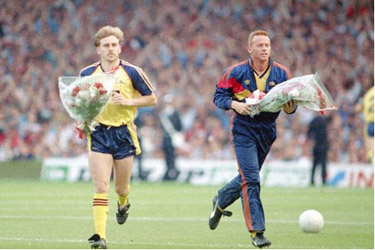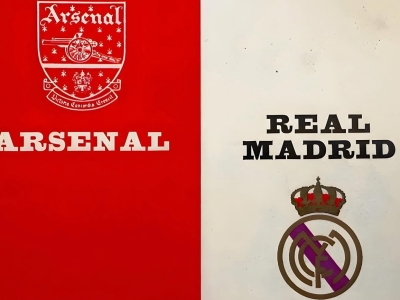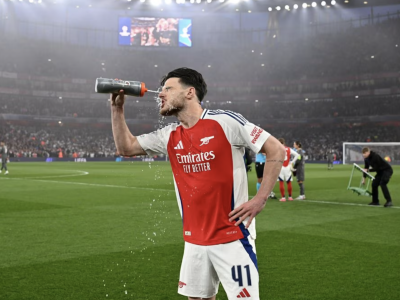Aside from Liverpool’s glorious treble in 1984, that same year Alan Bleasdale of ‘Boys from the Blackstuff’ fame would attempt to follow up his success with a Channel 4 series called ‘Scully’, which had a premise vaguely similar to Ken Loach’s ‘Looking for Eric’ only involving Liverpool stars such as Kenny Dalglish (and a lead actor pushing thirty playing a school pupil!). The show also co-starred Liverpool-born new wave star Elvis Costello who also performed the theme tune. However in 1984/85, Liverpool’s dominance would be rocked by the emergence of a new title rival across town and in October Everton took all three points at Anfield.
After just two wins out of eleven, Liverpool slipped as low as seventeenth, though managed to put a run together in the second half of the season defeating Arsenal 0-3 at Anfield in February with goals from Ian Rush, Phil Neal and Ronnie Whelan. Liverpool finished the season as runners up though thirteen points behind Champions Everton, though ended the season trophy-less for the first time since 1971/72 - however that statistic would be far from the biggest tragedy that season. As a result of the Heysel tragedy, English Football’s stock fell as low as it had ever gone and was partly the reason why the game disappeared from the TV screens for the first half of the 1985/86 season.
On the opening day of the season, Arsenal visited Anfield, where the Sydney Morning Herald would allege that a memorial service for those who died at Heysel would be marred by rival supporters, whose chanting would drown out the service. Goals from Steve Nicol and Ronnie Whelan inflicted a 0-2 defeat on the Gunners. At the start of November, though Liverpool were sitting second in the League they were as much as ten points behind rivals Man Utd who had got off to a flying start unbeaten for the first fifteen games.
The two sides would meet in the League Cup in Late November at Anfield – a game which many believed footage of which was lost to the TV black out. Liverpool triumphed 2-1 on the night with a superb goal from Jan Molby which luckily had been captured for posterity by private video. By the time of Man Utd’s next visit to Anfield in the League in February they had been pegged back after losing six games with Liverpool just two points behind. Unfortunately, Man Utd were welcomed by the Liverpool fans with CS Gas on arrival at Anfield. Unfortunately for football, the TV cameras had returned by February and the matter was given full exposure live on Match of the Day. The match itself ended in a 1-1 draw.
Meanwhile, Liverpool’s hopes of a treble ended after losing their League Cup Semi Final to QPR on aggregate, conceding two own goals at Anfield in the second leg. From early March however, in the League Liverpool went on an astounding run gaining thirty four points out of thirty six in their final twelve games, sealing the title on the final Saturday with a 1-0 win over Chelsea away at Stamford Bridge. A week later Liverpool sealed the double with a 3-1 win over Everton, this here is the post-match coverage with an interview with two-goal hero Ian Rush, as well as an early punditry outing for Andy Gray. The other great punditry giant of the nineties – Liverpool’s double winning captain Alan Hansen – would be interviewed here by Bob Wilson on Football Focus about that season’s exploits.
Three games into the 1986/87 season and a new era at Highbury under George Graham, Arsenal’s inability to get a result at Anfield still continued as Liverpool inflicted a 1-2 defeat on Arsenal with goals from Jan Molby and Ian Rush, while Tony Adams would be on target for Arsenal. This season however would be Liverpool’s second trophy-less term in three years, courtesy of George Graham winning his first trophy for Arsenal in April 1987 by defeating Liverpool 2-1 in the final at Wembley (with the match in its entirety shown here. The Liverpool board therefore allowed Kenny Dalglish a spending spree to rebuild Liverpool’s attack, signing Peter Beardsley, John Barnes, John Aldridge and Ray Houghton, which left even quality players such as Craig Johnston, Jan Molby and Kenny Dalglish himself (still registered as a player) without a place in the side throughout most of 1987/88.
By the time of Arsenal’s visit to Anfield in mid-January 1988, Liverpool had been twenty three games unbeaten and fifteen points clear of second place Nottingham Forest. The Merseysiders took all three points in a 0-2 defeat for Arsenal with goals from John Aldridge and Peter Beardsley. Liverpool were closing in on Leeds Utd’s fourteen year record of twenty nine games unbeaten from the start of the season, which had been equalled with a 1-1 draw away at Derby in mid-march, the thirtieth match however was covered live on ITV away at Goodison Park against rivals Everton who inflicted Liverpool’s first defeat of the season courtesy of a goal from Wayne Clarke – who ironically was younger brother of former Leeds marksman Alan (incidentally, the joint record stood until 2003/04 when surpassed by Arsenal’s ‘invincibles’, who’ll obviously hold that record until the unlikely event of an extension of a Premiership season beyond thirty eight games).
Liverpool lost a second league game that year to Nottingham Forest away two weeks later, though in the home fixture between the two sides eleven days later, Liverpool hammered fifth placed Forest 5-0 at Anfield. The Reds sealed their seventeenth title in 1987/88 and were on course for the double, meeting Wimbledon in the final – who had only been in the Football League since the same year as Liverpool’s first European Cup in 1977. Despite being red hot favourites, the Reds crashed to a 0-1 defeat masterminded by the old Arsenal combo of former coach Don Howe and former player Bobby Gould - covered by BT Sport’s acclaimed documentary ‘The Crazy Gang’.
Liverpool were most people’s favourites to retain their title at the start of the 1988/89 season after recapturing Ian Rush from Juventus, however early on lost captain Alan Hansen to injury, goalkeeper Bruce Grobbelaar to Meningitis and had Jan Molby imprisoned for a drink driving offence. Arsenal met Liverpool at Anfield in the third round of the League Cup at the start of November, which ended in a 1-1 draw with a superb David Rocastle strike cancelling out an opener from John Barnes. A week later, a crowd of 54,029 (the last ever crowd at Highbury to exceed 50,000) saw the replay, which ended 0-0. Two weeks on, the two sides played out the second replay at Villa Park, where Arsenal took the lead through a Paul Merson goal. However goals from Steve McMahon and John Aldridge inflicted a 1-2 defeat on Arsenal.
Liverpool however were underwhelming in the League during the first half of 1988/89, suffering a 0-1 home defeat to Norwich and a 1-3 defeat to Alex Ferguson’s Man United (in the era before those words actually stoked fear into anyone) on New Years’ Day. By the end of February, Liverpool fell nineteen points behind Arsenal (albeit Liverpool’s involvement in the FA Cup meant they had four games in hand). By the start of April, a 1-0 win over surprise title challengers Norwich put Liverpool two points behind Arsenal on equal games and ahead of Liverpool’s Semi-Final clash with Nottingham Forest had even took the top spot on goal difference after beating Millwall 2-1 at the Den.
Arsenal were due to meet Liverpool in the League at Anfield eight days after the Semi Final, the events at Hillsborough however changed not only the dynamics of the season but the future course of the football industry as a whole. This here is real time footage of the short duration of the game at Hillsborough (which I can appreciate may be distressing viewing for many, but is a must-see when you consider what’s was said on the matter of Hillsborough in its aftermath). What is striking from this footage is that if you look behind the goal at the Leppings Lane end, it’s clearly visible to the naked eye how the pens to the right hand side show far more space in comparison to the crush developing in the pens on the right, thus highlighting how poor crowd control on the day had obviously been.
@06.18 came what has subsequently become known as the ‘miracle of Hillsborough’ after a Peter Beardsley strike hit the bar – which had it gone in could have caused a crowd surge which might have brought even more fatalities than there actually were. Mercifully, the game is halted at six minutes and the RTE footage of the incident continues from here - two things of note are the visible absence of any Liverpool fans urinating on police, pick-pocketing dead victims and preventing brave PCs giving the kiss of life - as per the Sun Newspaper’s infamous headline under the banner of ‘the truth’, as well as how long the first ambulance takes to appear on the scene (its believed that as many as half of the fatalities that occurred that day could have been avoided had the response of the emergency services been more prompt.
There’s also often been a tendency to draw a correlation between Heysel and Hillsborough because both involved Liverpool fans, however the common denominator between the two is really how big games were policed in the 1980s – of which Liverpool were involved in many during that period. The fact of the matter is that another disaster at Hillsborough at the start of the decade was narrowly avoided involving Spurs fans in their Semi against Wolves in 1981 - One Tottenham fan’s account of events that day doesn’t sound entirely dissimilar from what was experienced by Liverpool fans eight years on, which - coupled with the fact that at the time of the disaster, Hillsborough had no safety certificate whatsoever - kind of underlines the fact that the events of that day really could have involved any set of football fans during the 1980s.
Two other pieces which shed further light on events that day are Jimmy McGovern’s TV Docu-Drama from 1996 and Panorama’s ‘How They Buried the Truth’ from 2014. The final death toll of Hillsborough stood at ninety six (as well as at least three suicides which have been attributed to the events of that day), around half of whom were under the age of twenty one - the youngest of which was ten year old Jon-Paul Gilhooley, who was the cousin of future Liverpool star Steve Gerrard. In the wake of Hillsborough, Arsenal resisted pressure from the Football League to resume fixtures in order to not be seen to be seeking a points advantage over Liverpool. Once Liverpool had decided to complete the remainder of the 1988/89 season, Arsenal played their first game just forty eight days prior to theirs.
Liverpool won the replayed Semi Final against Forest two weeks before the emotionally charged 1989 FA Cup Final against neighbours Everton, which the Red half of Merseyside won 3-2 after extra time. A 5-1 win over West Ham three days on meant that going into the final game showdown between the two sides, Liverpool took a three point lead and had a plus four goal difference advantage over Arsenal, meaning that only a win by two clear goals would give Arsenal the title. In the years since, there are some that have tried to portray Anfield ’89 as only occurring as a result of Liverpool’s grief at Hillsborough, this school of thought however severely downplays both the enormity of the task which faced Arsenal, as well as the on-pitch response of the Liverpool players in the games that followed Hillsborough.
Arsenal’s task was to win at Anfield – something they’d failed to do for fourteen and a half years prior to May 1989 (Arsenal had failed to even manage a draw in the League there since October 1980). Not just that, Arsenal had to win at Anfield by two clear goals – something no-one had done for over two seasons prior. Not only did Arsenal have to beat Liverpool (something no team had done since New Years’ Day, eighteen games prior), but they also had to stop Liverpool winning (something only one team – Merseyside rivals Everton - had managed to do in the previous fourteen games). It was undoubted that the Liverpool players - who in the days following Hillsborough attended many of the funerals of the victims - were deeply affected by the tragedy (one only had to look at their reaction after the final whistle against Arsenal, particularly that of childhood Kopite John Aldridge), yet their response on the pitch seemed to be to steam roll their way to the double in honour of those who died at Hillsborough – winning seven out of eight games in both the League and the FA Cup.
Arsenal were also a younger side with much less trophy winning experience than Liverpool and, in contrast to them, seemed to be providing a master class in how to blow a title race they’d been in pole position for since Christmas, after gaining just one point from a possible six in their last two fixtures – both at Highbury. The words of the Daily Mirror’s Sports section after Liverpool’s 5-1 win over West Ham said it all: ‘You Haven't Got A Prayer, Arsenal’. However, above all, it severely downplays just how well George Graham got his tactics for the game spot on, especially as re-told in an interview with Perry Groves for Goal.com.
Groves states that George’s tactics to his players ahead of Anfield were that: ‘If we concede the first goal we’re finished…You ain’t going to score three. It just doesn’t happen [at Anfield]. But if we get in at half-time 0-0 we’ve won half the battle, and then we’ll have a chat at half-time and I fancy us to nick a goal in the second half, and if we do then it’s all about momentum, pressure gets to people. If we can score, the momentum will change and all the pressure then goes on Liverpool’. With the exception of Steve Bould nearly scoring early on, the first half (shown in its entirety here) panned out as exactly as George Graham had planned. The crucial turning point of the game was to come seven minutes into the second half with Alan Smith putting Arsenal one up.
Smith’s goal immediately brought a unified response of panic from the Liverpool players, who were harassing the referee to disallow the goal - though they were most probably not entirely coherent on what infringement they were actually protesting. Some claimed handball, some offside, others claimed that from this indirect free kick Smith hadn’t even touched the ball. TV replays from every available angle however clearly proved that Smith’s goal was perfectly legitimate and crucially so too did the referee, regardless of what 40,000 Liverpool fans at Anfield thought at the time. For those who have only in the years since ever seen the edited second half highlights, this footage here of the Second half in its entirety reminds just how end to end the match was after the first goal went in.
As the second half progressed, George Graham reverted to 4-4-2 after starting with five across the back, with Thomas very nearly grabbing Arsenal’s second a lot earlier but hitting it straight at Grobbelaar. The ending of course is known the world over and has since passed into folklore with Thomas grabbing the winner deep into injury time. In contrast to the modern phenomenon of leaving before the final whistle, the Kop actually remained for the trophy presentation. As explained by Perry Groves: ‘we got a standing ovation from the Kop, who had stayed there [after the final whistle] because I think they appreciated the way we’d gone about the game. We didn’t go there and try and boot them off the park, and they’re a very respectful crowd. They know good football’.








